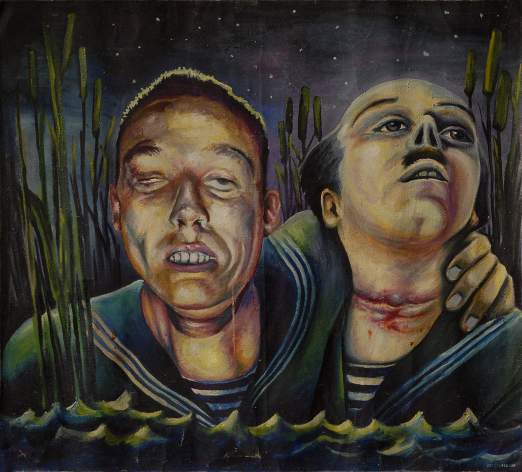The beginning of the 1980s. A woman with a perm in bright tights is walking around St. Petersburg. A man in a stretched Puma sweater brought by his uncle from Germany, looks at her. A woman notices his gaze and smiles shyly. Meanwhile, in the same city, Yevgeny Yufit and his punk friends get drunk, stage performances based on imitating fights and beating a mannequin used for forensic examinations. Later, Yufit began to take the first necro photographs depicting subjects with zombie characterization made with bandages and tomato paste.
To perpetuate performances, Yevgeny took an amateur camera in his hands. Randomly-edited short films were produced by DIY- film production company “Mzhalalafilm” (“mzha” means unconscious, “lala” – a chatter). The first neсrorealistic film Werewolf Orderlies was shot in 1984 and after that Yufit made more short films such as: Lumberjack (1985), Spring (1987) and Suicide Warthogs (1988), as well as his first feature film Daddy, Father Frost Is Dead (1989), which was awarded the Grand Prix at the Amarcort Film Festival in 1992.
The formula for Necrorealistic films was quite simple: everything was made by the first shot on a 16 mm camera and the actors did not have a script, so they could act as they wanted. “Stupidity, courage and the greatest crime of all possible” – this is how Necrorealists determined their style.
Although the term “Necrorealism” is associated with “socialist realism”, it should not be understood as deriding Soviet propaganda. Necrorealists sought to show the dualistic nature of art – “necro” as “dead” and at the same time “realism” in other words “alive”, so the main theme in Necrorealism endless biological death. The art movement, which existed only in Russia from the early 1980s to mid-1990s flourished when leaders died one after another, and the Soviet utopia of immortality started to collapse with them.

Werewolf Orderlies, dir. Yevgeny Yufit, 1984
Necrorealism ignored all the technical achievements of the film industry intentionally. According to Yufit, through his technique he deformed visual perception, thereby preventing the free associations, due to which the influence of surrealists on Necrorealists becomes noticeable. Dadaism is another avant-garde movement that inspired Necrorealism – however, not in the context of form, but of spirit. Representatives of both movements ignored traditional forms of art and similarly played with the language: dadaists cut out words from newspapers, creating new poetry, while the Necrorealists sought to remove the semantic load of the words in their works.
Also, in any short film produced by “Mzhalalafilm”, there is an aura of German expressionism. The Weimar Germans, like the Necrorealists, appreciated the subjectivity of the creative act. Friedrich Wilhelm Murnau, Fritz Lang, Robert Wiene and others tried to reach the subconscious of the viewer, like when they portrayed people moving to sound dissonances, maneuvering between silence and disturbing sounds, as live meat. – The Necrorealists worked towards the same goal. Another non-obvious parallel is interest in medicine, but if for Necrorealists human cognitive functions were similar to the ones of animals, for expressionists doctors and hospitals were elements of horror.
Necrorealists were also influenced by the work of Andrei Tarkovsky, and sometimes it even seemed that Yufit was a fan of the conceptual solutions of the Russian master: long static shots, immersion of the viewer into the atmosphere of the film, experiments with sound and deafening silence. In the late 90s, Yevgeny began experimenting with sepia and practically copied Stalker. It would seem that the use of these methods should have been interpreted as a tribute to the famous director, but because it was performed by Necrorealists it looked like an ironic joke and an attempt to demonstrate how Tarkovsky’s films would look without any intellectual meaning, but Yufit denied similarity with the works of the genius.
It is worth noting that Necrorealists not only made films, but also took photographs, drew, wrote music, arranged exhibitions, wrote scientific works and even stories for children: Leonid Trupyr (Konstantinov) made one of the most famous necro paintings In the reeds; Valery Morozov, being the only necro-sculptor, created the cycle of wooden idols Istukan; Andrei Dead (Kurmayartsev), together with Yevgeny Debil, wrote the study “Flora and Fauna of Graves” in 1986 for the magazine “Cinephantom.”

Leonid Trupyr – In the reeds, 1987
Combining Eastern and Western traditions, Necrorealists created something fundamentally new. They rejected everything that conventionally turns art into art, ridding it of beauty and existence. Without a doubt Necrorealist managed to create an image of death, and then make fun of it.











